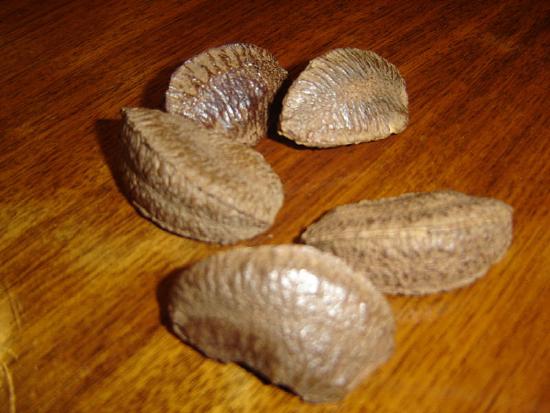Food Irradiation and Radioactivity in Foods
- Page ID
- 50770
\( \newcommand{\vecs}[1]{\overset { \scriptstyle \rightharpoonup} {\mathbf{#1}} } \)
\( \newcommand{\vecd}[1]{\overset{-\!-\!\rightharpoonup}{\vphantom{a}\smash {#1}}} \)
\( \newcommand{\dsum}{\displaystyle\sum\limits} \)
\( \newcommand{\dint}{\displaystyle\int\limits} \)
\( \newcommand{\dlim}{\displaystyle\lim\limits} \)
\( \newcommand{\id}{\mathrm{id}}\) \( \newcommand{\Span}{\mathrm{span}}\)
( \newcommand{\kernel}{\mathrm{null}\,}\) \( \newcommand{\range}{\mathrm{range}\,}\)
\( \newcommand{\RealPart}{\mathrm{Re}}\) \( \newcommand{\ImaginaryPart}{\mathrm{Im}}\)
\( \newcommand{\Argument}{\mathrm{Arg}}\) \( \newcommand{\norm}[1]{\| #1 \|}\)
\( \newcommand{\inner}[2]{\langle #1, #2 \rangle}\)
\( \newcommand{\Span}{\mathrm{span}}\)
\( \newcommand{\id}{\mathrm{id}}\)
\( \newcommand{\Span}{\mathrm{span}}\)
\( \newcommand{\kernel}{\mathrm{null}\,}\)
\( \newcommand{\range}{\mathrm{range}\,}\)
\( \newcommand{\RealPart}{\mathrm{Re}}\)
\( \newcommand{\ImaginaryPart}{\mathrm{Im}}\)
\( \newcommand{\Argument}{\mathrm{Arg}}\)
\( \newcommand{\norm}[1]{\| #1 \|}\)
\( \newcommand{\inner}[2]{\langle #1, #2 \rangle}\)
\( \newcommand{\Span}{\mathrm{span}}\) \( \newcommand{\AA}{\unicode[.8,0]{x212B}}\)
\( \newcommand{\vectorA}[1]{\vec{#1}} % arrow\)
\( \newcommand{\vectorAt}[1]{\vec{\text{#1}}} % arrow\)
\( \newcommand{\vectorB}[1]{\overset { \scriptstyle \rightharpoonup} {\mathbf{#1}} } \)
\( \newcommand{\vectorC}[1]{\textbf{#1}} \)
\( \newcommand{\vectorD}[1]{\overrightarrow{#1}} \)
\( \newcommand{\vectorDt}[1]{\overrightarrow{\text{#1}}} \)
\( \newcommand{\vectE}[1]{\overset{-\!-\!\rightharpoonup}{\vphantom{a}\smash{\mathbf {#1}}}} \)
\( \newcommand{\vecs}[1]{\overset { \scriptstyle \rightharpoonup} {\mathbf{#1}} } \)
\( \newcommand{\vecd}[1]{\overset{-\!-\!\rightharpoonup}{\vphantom{a}\smash {#1}}} \)
\(\newcommand{\avec}{\mathbf a}\) \(\newcommand{\bvec}{\mathbf b}\) \(\newcommand{\cvec}{\mathbf c}\) \(\newcommand{\dvec}{\mathbf d}\) \(\newcommand{\dtil}{\widetilde{\mathbf d}}\) \(\newcommand{\evec}{\mathbf e}\) \(\newcommand{\fvec}{\mathbf f}\) \(\newcommand{\nvec}{\mathbf n}\) \(\newcommand{\pvec}{\mathbf p}\) \(\newcommand{\qvec}{\mathbf q}\) \(\newcommand{\svec}{\mathbf s}\) \(\newcommand{\tvec}{\mathbf t}\) \(\newcommand{\uvec}{\mathbf u}\) \(\newcommand{\vvec}{\mathbf v}\) \(\newcommand{\wvec}{\mathbf w}\) \(\newcommand{\xvec}{\mathbf x}\) \(\newcommand{\yvec}{\mathbf y}\) \(\newcommand{\zvec}{\mathbf z}\) \(\newcommand{\rvec}{\mathbf r}\) \(\newcommand{\mvec}{\mathbf m}\) \(\newcommand{\zerovec}{\mathbf 0}\) \(\newcommand{\onevec}{\mathbf 1}\) \(\newcommand{\real}{\mathbb R}\) \(\newcommand{\twovec}[2]{\left[\begin{array}{r}#1 \\ #2 \end{array}\right]}\) \(\newcommand{\ctwovec}[2]{\left[\begin{array}{c}#1 \\ #2 \end{array}\right]}\) \(\newcommand{\threevec}[3]{\left[\begin{array}{r}#1 \\ #2 \\ #3 \end{array}\right]}\) \(\newcommand{\cthreevec}[3]{\left[\begin{array}{c}#1 \\ #2 \\ #3 \end{array}\right]}\) \(\newcommand{\fourvec}[4]{\left[\begin{array}{r}#1 \\ #2 \\ #3 \\ #4 \end{array}\right]}\) \(\newcommand{\cfourvec}[4]{\left[\begin{array}{c}#1 \\ #2 \\ #3 \\ #4 \end{array}\right]}\) \(\newcommand{\fivevec}[5]{\left[\begin{array}{r}#1 \\ #2 \\ #3 \\ #4 \\ #5 \\ \end{array}\right]}\) \(\newcommand{\cfivevec}[5]{\left[\begin{array}{c}#1 \\ #2 \\ #3 \\ #4 \\ #5 \\ \end{array}\right]}\) \(\newcommand{\mattwo}[4]{\left[\begin{array}{rr}#1 \amp #2 \\ #3 \amp #4 \\ \end{array}\right]}\) \(\newcommand{\laspan}[1]{\text{Span}\{#1\}}\) \(\newcommand{\bcal}{\cal B}\) \(\newcommand{\ccal}{\cal C}\) \(\newcommand{\scal}{\cal S}\) \(\newcommand{\wcal}{\cal W}\) \(\newcommand{\ecal}{\cal E}\) \(\newcommand{\coords}[2]{\left\{#1\right\}_{#2}}\) \(\newcommand{\gray}[1]{\color{gray}{#1}}\) \(\newcommand{\lgray}[1]{\color{lightgray}{#1}}\) \(\newcommand{\rank}{\operatorname{rank}}\) \(\newcommand{\row}{\text{Row}}\) \(\newcommand{\col}{\text{Col}}\) \(\renewcommand{\row}{\text{Row}}\) \(\newcommand{\nul}{\text{Nul}}\) \(\newcommand{\var}{\text{Var}}\) \(\newcommand{\corr}{\text{corr}}\) \(\newcommand{\len}[1]{\left|#1\right|}\) \(\newcommand{\bbar}{\overline{\bvec}}\) \(\newcommand{\bhat}{\widehat{\bvec}}\) \(\newcommand{\bperp}{\bvec^\perp}\) \(\newcommand{\xhat}{\widehat{\xvec}}\) \(\newcommand{\vhat}{\widehat{\vvec}}\) \(\newcommand{\uhat}{\widehat{\uvec}}\) \(\newcommand{\what}{\widehat{\wvec}}\) \(\newcommand{\Sighat}{\widehat{\Sigma}}\) \(\newcommand{\lt}{<}\) \(\newcommand{\gt}{>}\) \(\newcommand{\amp}{&}\) \(\definecolor{fillinmathshade}{gray}{0.9}\)People are concerned about the possibility of radioactivity being induced in foods by the irradiation sometimes used to kill microorganisms.

Although no radioactivity has been detected as a result of irradiation, there may be radioactivity present in foods to begin with. Since radioactivity is present in soils, it's not surprising that it ends up in plants and in animals we use for food, and in our bodies. The brazil nut has the highest radioactivity of any food.

Radioactivity results from decay of an unstable nuclide to produce a different daughter or product nuclide. In a "transmutation", the daughter is a different element. The process is accompanied by the release of one or more particles associated with "radioactivity", as shown below. We report the quantity of a radioactive isotope in terms of its activity, or the number of decays per second. The number of decays per second is called a Becquerel (1 Bq = 1 decay or disintegration per second). High activities are often reported in curies (Ci; 1 Ci = 3.7 x 1010 d/s). The total activity in a brazil nut can be around 1000 Bq/kg, coming from roughly equal activities of \({}_{\text{88}}^{\text{226}}\text{Ra}\), \({}_{\text{88}}^{\text{228}}\text{Ra}\) and \({}_{\text{19}}^{\text{40}}\text{K}\).
Beta Emission
Potassium-40, \({}_{\text{19}}^{\text{40}}\text{K}\), is the most common radionuclide in food. It decays in two ways. About 89% of the time it decays to \({}_{\text{20}}^{\text{40}}\text{Ca}\) by "beta" emission, where each decay produces a "beta" particle:
\[{}_{\text{19}}^{\text{40}}\text{K} \rightarrow {}_{\text{20}}^{\text{40}}\text{Ca} + {}_{\text{-1}}^{\text{0}} \beta \]
Beta decay increases the number of protons, so it transmutes an element into the element with the next higher atomic number. It occurs when a nucleus has a high n/p ratio (compared to the stable nuclei of that element).
Note that the sum of the atomic numbers on the left is the same as the sum of the atomic numbers on the right, assuming that we arbitrarily assign -1 to the β (20 = 19 + (-1)). The sum of the mass numbers is also the same on left and right(40 = 40 + 0).
Although beta particles are identical to electrons, they come from the nucleus by decay of a neutron to a proton and the beta:
\[{}_{\text{0}}^{\text{1}}\text{n} \rightarrow {}_{\text{1}}^{\text{1}}\text{p} + {}_{\text{-1}}^{\text{0}} \beta \]
Positron and Gamma Emission
The nuclide \({}_{\text{19}}^{\text{40}}\text{K}\) also decays by "positron" emission to \({}_{\text{18}}^{\text{40}}\text{Ar*}\) in an excited state (indicated by an asterisk in its symbol), which then decays to ground state \({}_{\text{18}}^{\text{40}}\text{Ar}\) by emitting a "gamma ray":
\[{}_{\text{19}}^{\text{40}}\text{K} \rightarrow {}_{\text{18}}^{\text{40}}\text{Ar*} + {}_{\text{+1}}^{\text{0}} \beta \]
\[{}_{\text{18}}^{\text{40}}\text{Ar*} \rightarrow {}_{\text{18}}^{\text{40}}\text{Ar} + {}_{\text{0}}^{\text{0}} \gamma \]
Positrons ( \({}_{\text{+1}}^{\text{0}} \beta\) ) are the antiparticle of the beta, and they soon collide with orbiting electrons and annihilate to form two gamma rays. Thus gamma rays are the ultimate result of positron emission:
\[{}_{\text{+1}}^{\text{0}} \beta + {}_{\text{-1}}^{\text{0}} \beta \rightarrow {}_{\text{0}}^{\text{0}} \gamma\]
A gamma ray is not a particle (it's electromagnetic radiation like an X-ray), and so its emission from a nucleus does not involve a change in atomic number or mass number. Rather it involves a change in the way the same protons and neutrons are packed together in the nucleus. Again, note that the nuclear equations are balanced, because the sum of the atomic numbers is the same on the left and right, and the sum of mass numbers is the same on both sides.
The activity due to \({}_{\text{19}}^{\text{40}}\text{K}\) in foods varies from 45.9 to 649.0 Bq/kg[2], and our bodies contain about 63 Bq/kg (see Table below), which apparently does no harm, and accoding to the "radiation hormesis hypothesis" may actually be beneficial.
Alpha Emission
The other common radioisotopes found in food are \({}_{\text{88}}^{\text{226}}\text{Ra}\) and \({}_{\text{90}}^{\text{228}}\text{Th}\) which vary from 0.01 to 1.16 Bq/kg and 0.02 to 1.26 Bq/kg respectively [3]. These activities are much lower than the potassium-40 activity, but are still regarded as significant because the type of particle formed, the α particle (\({}_{\text{2}}^{\text{4}}\text{He}\)), can be much more damaging. The activity of \({}_{\text{88}}^{\text{226}}\text{Ra}\) in our bodies is about 2.7x10-5 Bq/kg[4].
\[{}_{\text{88}}^{\text{226}}\text{Ra} \rightarrow {}_{\text{86}}^{\text{222}}\text{Rn*} + {}_{\text{2}}^{\text{4}}\alpha \]
\[{}_{\text{90}}^{\text{228}}\text{Th} \rightarrow {}_{\text{88}}^{\text{224}}\text{Ra*} + {}_{\text{2}}^{\text{4}}\alpha \]
Again, note that these nuclear equations are balanced. Since the α particle consists of two protons and two neutrons, the atomic number must be reduced by 2 and the mass number by 4. Alpha decay is typical for large nuclei, because it reduces their size rapidly. Every element above Z = 83 (Bi) is radioactive, apparently because no number of neutrons can stabilize the nucleus against the repulsions between large numbers of protons.
Table \(\PageIndex{1}\) Common Nuclides in Food and in Our Body:
|
|
It is important to note that radioactivity and transmutation both involve changes within the atomic nucleus. Such nuclear reactions will be discussed in more detail in the section devoted to Nuclear Chemistry. Because protons and neutrons are held tightly in the nucleus, nuclear reactions are much less common in everyday life than chemical reactions. The latter involve electrons surrounding the nucleus, and these are much less rigidly held.
Example \(\PageIndex{1}\): Cobalt Decay
Food is irradiated with cobalt-60, which decays by beta emission to a nickel isotope. The nickel isotope decays by the gamma emission which is the radiation primarily responsible for killing microorganisms. Write nuclear equations for the two decays.
Solution:
All cobalt has atomic number 27, so the reactant nuclide is \({}_{\text{27}}^{\text{60}}\text{Co}\). Since it decays by beta emission, we can deduce that the mass number of the nickel must also be 60, since the mass number of the beta is 0. Since nickel has Z = 28, the daughter isotope is \({}_{\text{28}}^{\text{60}}\text{Ni}\):
\[{}_{\text{27}}^{\text{60}}\text{Co} \rightarrow {}_{\text{28}}^{\text{60}}\text{Ni*} + {}_{\text{-1}}^{\text{0}} \beta \nonumber\]
The "excited" \({}_{\text{28}}^{\text{60}}\text{Ni}\)* then decays by gamma emission:
\[{}_{\text{28}}^{\text{60}}\text{Ni*} \rightarrow {}_{\text{28}}^{\text{60}}\text{Ni} + {}_{\text{0}}^{\text{0}} \gamma \nonumber\]
From ChemPRIME: 4.12: Transmutation and Radioactivity
References
- ↑ http://www.funtrivia.com/askft/Question32951.html
- ↑ IAEA-TECDOC-1287, Natural and Induced Radioactivity in Food" 2002, http://www-pub.iaea.org/MTCD/publications/PDF/te_1287_prn.pdf
- ↑ IAEA-TECDOC-1287, Natural and Induced Radioactivity in Food" 2002, http://www-pub.iaea.org/MTCD/publications/PDF/te_1287_prn.pdf
- ↑ IAEA-TECDOC-1287, Natural and Induced Radioactivity in Food" 2002, http://www-pub.iaea.org/MTCD/publications/PDF/te_1287_prn.pdf
- ↑ Handbook of Radiation Measurement and Protection, Brodsky, A. CRC Press 1978 and Environmental Radioactivity from Natural, Industrial and Military Sources, Eisenbud, M and Gesell T. Academic Press, Inc. 1997.http://www.physics.isu.edu/radinf/natural.htm
- ↑ Handbook of Radiation Measurement and Protection, Brodsky, A. CRC Press 1978 and Environmental Radioactivity from Natural, Industrial and Military Sources, Eisenbud, M and Gesell T. Academic Press, Inc. 1997.http://www.physics.isu.edu/radinf/natural.htm
Contributors and Attributions
Ed Vitz (Kutztown University), John W. Moore (UW-Madison), Justin Shorb (Hope College), Xavier Prat-Resina (University of Minnesota Rochester), Tim Wendorff, and Adam Hahn.


